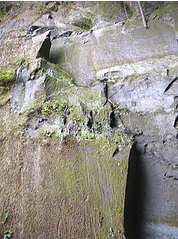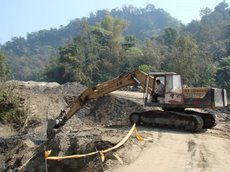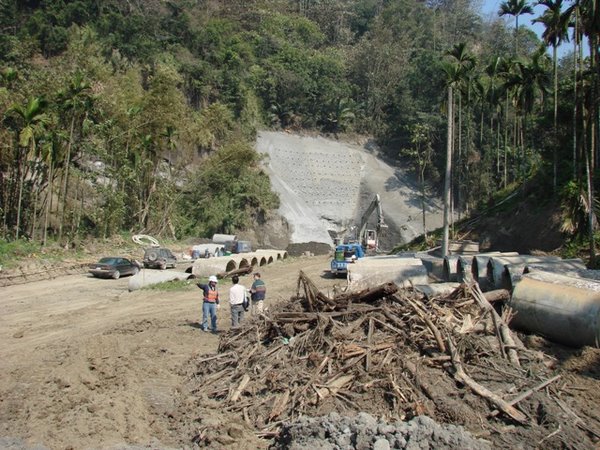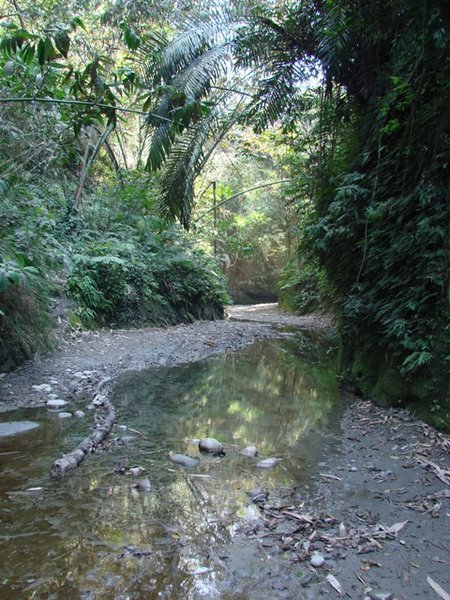Taiwan National Coalition Against the Hushan Dam
Plans were first laid to submerge You-cing Valley in December 1994. Located in the Hushan area, 10 km south-east of Douliu City in Yunlin County, the valley would be filled with water diverted from the Cing-shui River and dammed just north of Hushan Village. The resulting reservoir would, according to developers, provide the means to relieve Yunlin County of its shortage of agricultural and domestic water, and mitigate the serious land subsidence that had occurred through excessive pumping of groundwater. More than ten years later, however, the dam still exists only on paper, and a growing number of people are fighting to keep it that way.
You-cing Valley: Wild at Heart
You-cing Valley carves a winding path through lush forest that has survived and replenished itself since the last major forestry exploitation in the area by the former KMT government after 1949. Protected by law in recent years under the management of the Forestry Bureau, the valley offers more than a shady walk for people escaping the stress of the city; birdwatchers and academics have recorded a wealth of animal species to whom the plants and pools provide either a permanent home, or a vital resting and breeding ground along migration routes.
The diversity of life in Hushan presents itself throughout the day as a vibrant spectrum of sounds and colors. The hiss and hum of cicadas and bees resonate from amidst flowers, leafy green vegetation and creaking bamboo, punctuated by the various taps, whistles and squeaks of birds including the Taiwan Partridge Arborophila crudigularis and Swinhoe's Pheasant Lophura swinhoii, two of six endemic bird species recorded in the area. A gradually mounting chorus of croaks and rattles hints at the vast concealed army of resident amphibians; 21 of Taiwan’s 31 frog species have been spotted at Hushan. And in early April, dense clouds of Taiwan Purple Crow Butterflies (Euploea tulliolus) can be seen taking off as they begin their northward migration.
Brown tree frog: Wild Bird Society of Yunlin
One particularly striking bird, the Fairy Pitta Pitta nympha, finds its way to You-cing Valley every year from countries such as Malaysia and Indonesia. Known in Mandarin as the "Eight-colored Bird", it arrives in late spring, and is seen hopping along the ground looking for earthworms, its multi-colored feathers gleaming brilliantly when caught the sunlight. Threatened by habitat destruction, only about 3,000-5,000 Fairy Pitta remain worldwide. It is listed as a vulnerable bird by Birdlife International and the International Union for the Conservation of Nature (IUCN), and regulated under the Convention on International Trade in Endangered Species (CITES), and is listed as an endangered species in Taiwan, where Hushan provides the world’s most densely populated Fairy Pitta habitat known to date.
Fairy Pitta: Wild Bird Society of Yunlin
International recognition of this shrinking population brought Birdlife International representatives to Taiwan in 2000 to voice concern over exploitation of local forest resources. Later, in 2004, in a letter addressed to President Chen Shui-bian, the organization's director, Mike Rands, asked that the government confer greater protection status on the Fairy Pitta habitat. Specifically addressing the Hushan dam proposal, Rands also echoed Taiwanese environmentalists in asking that a new Environmental Impact Assessment (EIA) of the project be conducted, taking into consideration the importance of the area's ecosystems, as well as the viable, low cost alternatives that had been suggested in place of the dam.
However, even with protection under the law and the work of activists at home and abroad, rich ecosystems such as that of You-cing Valley are not out of danger; the growing pressure of corporate and political interest in the Hushan dam project led in January 2005 to agreement by the Forestry Bureau to release the land from under its control, making it available to developers. Water shortages and subsidence in Yunlin County were again cited as grounds for urgency in approving and starting construction. However, whether or not the dam was a viable solution to Yunlin’s water problems remained the subject of heated debate, and according to many who had studied the valley environment, it would even be a highly dangerous project.
Valley Walls: Wild at Heart
From a distance, the walls of the valley appear strong and solid. However, as demonstrated repeatedly by ecologists visiting the area, the stone breaks off easily and turns to powder between the fingers. The September 1999 earthquake, which had a magnitude of 7.3, and subsequent typhoons have caused the fragile hillsides to collapse, clogging the Cing-shui River and turning one upstream lake into a mud plain. A small weir built in an attempt to control the flow of sand now stands silted up to the brim, and some say the same fate lies in store for the Hushan dam, estimating a lifespan of only ten to 20 years. The original EIA, opponents argue, not only overlooked the biodiversity of the area; it also failed to address the potential silting up of the dam, and the fact that an earthquake on a similarly large scale could cause it to collapse.
Silted-up weir, You-cing Valley: Wild at Heart
To concerned locals and environmental groups, however, this was only part of a much larger issue. At the same time as government agencies were endorsing the dam project as a solution to Yunlin's existing water problems, separate plans were being laid for two major construction projects on Yunlin's offshore business park. Two corporations were vying for space to set up factories--Formosa Plastics for a steelworks, and Chinese Petroleum Corporation for a petrochemical science and technology park. The January 2005 decision to release the Hushan area from the protection of the Forestry Bureau coincided with a report confirming the suspicions of environmental groups that the offshore construction projects were linked to the dam project; the Ministry of Economic Affairs revealed that the corporations would both be allowed to build factories, and the dam would be built to meet an enormous future demand for water by these two notorious polluters. Further development along the west coast will also spell disaster for Taiwan's unique and highly threatened population of Indo-Pacific humpback dolphin.
Mailiao, Yunlin, Home of Formosa Plastics' Sixth Naptha Cracker Plant: Li Gen-jheng
To residents of Yunlin who trust in the promotional information they have received, the project still represents a solution to their water needs. Those who do not live near Hushan do not feel threatened by the potential collapse of the dam--and why should there be concern, when the engineers are so confident in their ability to overcome the forces of nature that they see no need to disclose their solutions for public review? But to those who have studied the ecology and geology of the proposed dam site, and the health and environmental effects of factories such as those planned for the business park, the risks and sacrifices involved in the Hushan dam project far outweigh the benefits of channeling more of the county's scarce resources into the hands of a few powerful corporations.
A comprehensive report on the Hushan Dam project is available in Mandarin at the Ecological Education Center. An excerpt of this book is also available in English.
Help Save The Fairy Pitta
Voice your concern for the Fairy Pitta by sending a Letter of Concern to the Taiwan Government and help us stop the Hushan Dam.
Monday, April 30, 2007
The Hushan Dam Project
Posted by
psilotum
at
2:06 AM
![]()
Subscribe to:
Post Comments (Atom)








1 comment:
TREES ARE THE BEST DAMS:THEY DEFY GRAVITY!
Dear Fellow Earth Residents:
Electric Load Demand triggers DETERMINISTICALLY worldwide earthquakes because dams meet the load changes by building giant surge waves of pressure heads of 100 km/sec or more at centers of gravity of water masses behind reservoirs in heavily dammed regions. This finding appears as a new publication at
http://damsquakeskosirivershifts.blogspot.com/
The plethora of dams already there and now being built at a feverish pace in Asia,China,Iran and other parts of the world will result in a catastrophe harming the entire globe by enormous heating,hurricanes,cyclones,floods,fires,landslides and with increased numbers of nuclear power plants result in genpatsu-shinsai-a simultaneous earthquake and nuke melt at the same location(It almost happened at Kasiwasaki Kariwa on 16th July 2007 and the giant unit there is still shut down). Of course, complete melting of snow caps, glaciers, the arctic and the antarctic will occur at a furious pace.And perennial Himalayan river flow will vanish.
Something urgently must be done. One step is reforestation using the world's dams on an emergency do or die pace. That forests are infinitely superior to dams which are helpless against gravity has been brought out conclusively in
http://treesandmaheshwar.blogspot.com/
and
http://practicethevedas.blogspot.com/
Vote for Change. Even trillions of present value dollars for a business as usual future is bound to be useless.
Hoping for a change to normalcy,
With best regards,
R. Ashok Kumar,B.E.,M.E(Power),Negentropist,Bombay Sarvodaya Mandal,299,Tardeo Road,Nana Chowk,Mumbai-400007.
Post a Comment